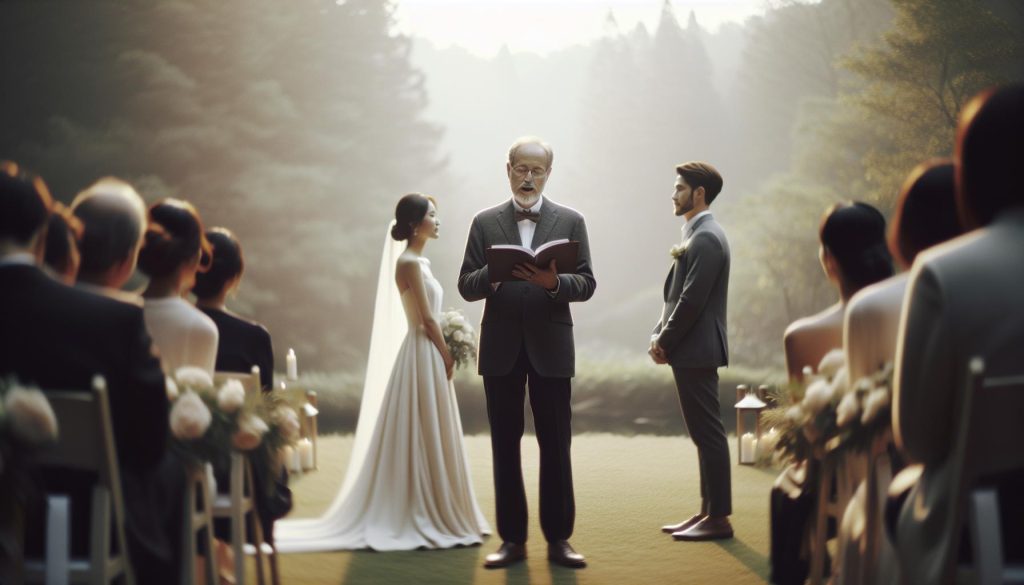When planning your wedding, one of the key elements that brings your ceremony to life is the officiant’s script. This important aspect not only sets the tone for the event but also encapsulates the love and commitment you share with your partner. From heartfelt vows to meaningful readings, what the officiant says can elevate your ceremony and leave a lasting impression on your guests. Many couples may feel overwhelmed when it comes to crafting the perfect script, but understanding the typical components and personalizing them allows for a truly memorable experience. Join us as we explore diverse script ideas that resonate with your unique love story, ensuring your special day reflects your values and traditions. Let’s dive into the heart of wedding officiation to discover inspiring suggestions that can guide you through this beautiful journey.
Understanding the Role of the Officiant at Your Wedding
The officiant is the heart and soul of a wedding ceremony, serving as the guide who seals the couple’s vows with their unique style and presence. Acting as a bridge between the couple and their guests, the officiant sets the stage for this monumental life event, creating an atmosphere of love and celebration. Whether a friend, family member, or hired professional, the officiant’s role is crucial in not only leading the ceremony but also in ensuring that every significant moment is beautifully articulated.
A wedding officiant typically begins the ceremony with a warm welcome, encouraging everyone present to embrace the joy of union. From here, the officiant might share insights about the couple’s journey together, making the experience more personal and relatable. This narrative serves not just to engage the guests but also to frame the significance of what is about to unfold. Essential to this role is the ability to maintain a balance between lightheartedness and reverence, ensuring that the ceremony resonates with the couple’s personality while respecting the atmosphere of the occasion.
In addition to the spoken words that accompany key rituals-such as the exchange of vows and rings-the officiant may also facilitate special readings or traditions that hold meaning for the couple. These elements might integrate cultural backgrounds or family customs, all contributing to the ceremony’s depth and richness. By tailoring the script to reflect the couple’s desires and values, the officiant creates a ceremony that is not only memorable but also deeply meaningful, allowing the couple’s personalities and love story to shine.
Furthermore, the officiant is responsible for adhering to legal requirements, ensuring that the marriage is recognized by law. This includes completing necessary paperwork and understanding local marriage laws. Thus, being an officiant involves multiple layers of preparation, from script development to legal obligations, all aimed at crafting the perfect ceremony for the couple’s milestone moment. Celebrating love, building connections, and commemorating traditions are at the heart of an officiant’s role, making their contribution invaluable to the wedding day.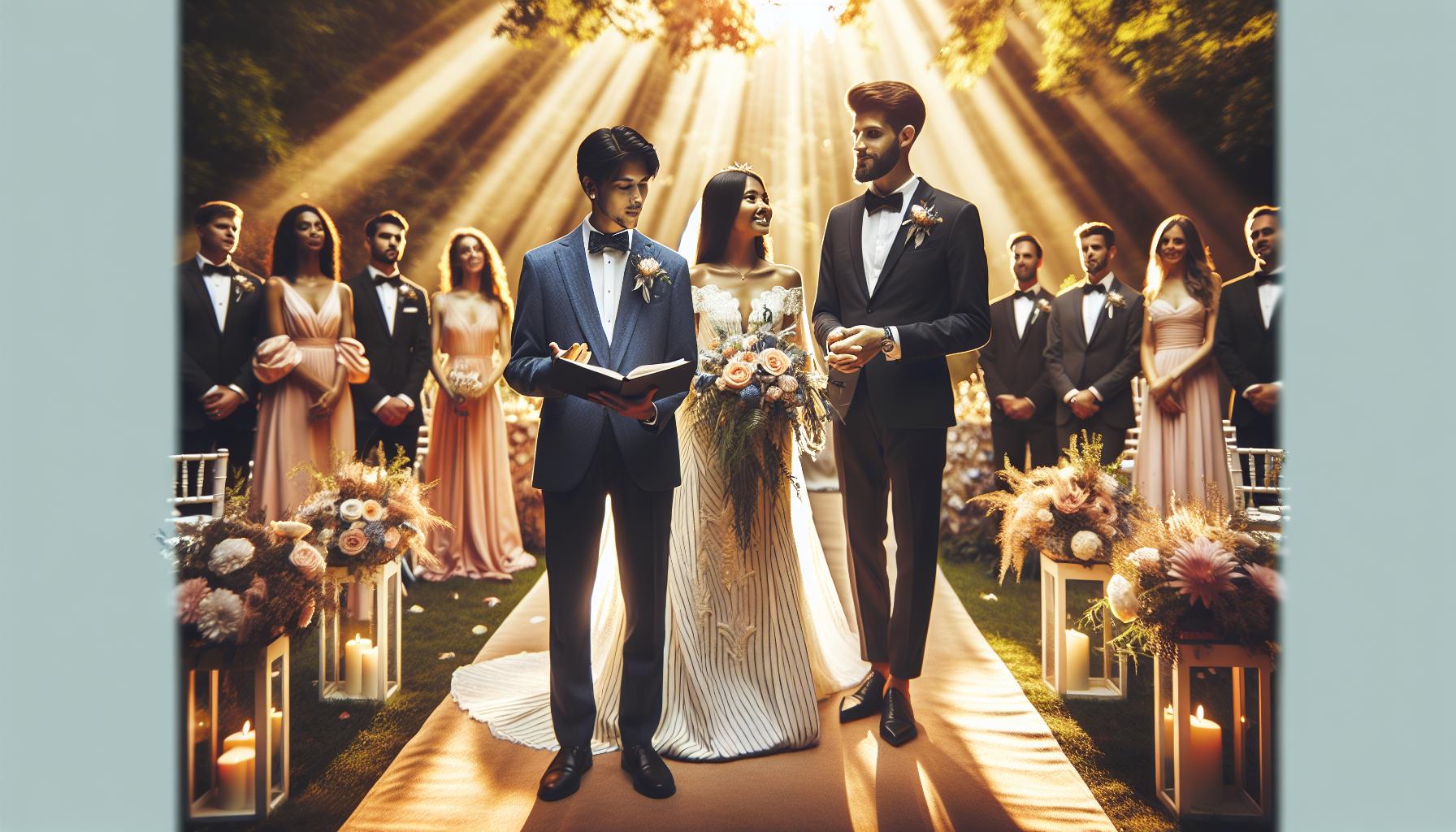
Essential Wedding Officiant Scripts to Consider
Creating the perfect wedding ceremony script is a labor of love that weaves together the couple’s story, their shared values, and the support of their community. A well-crafted script not only serves as a roadmap for the officiant but also enriches the overall experience for everyone present. It captures the essence of the couple’s bond and sets the tone for the significant moments that unfold during the ceremony.
To begin, consider including key components that reflect the couple’s personalities and preferences. Here are some essential elements that can enhance your wedding officiant script:
Welcome and Introduction
A warm welcome is crucial as it sets the atmosphere for the ceremony. Phrases such as, “We are gathered here today to celebrate the love and union of [Partner A] and [Partner B],” invite guests to embrace the joyful occasion. The officiant might also share a brief story about the couple to personalize this moment, highlighting how they met or what makes their relationship unique.
The Meaning of Marriage
Incorporating a meaningful message about marriage can elevate the ceremony. This could be a reflection on love, commitment, and partnership that resonates with the couple’s values. An example could be, “Marriage is a promise between two people who love each other and will be a source of strength, support, and joy in each other’s lives.”
Vows
The couple’s vows are the heart of the ceremony. Whether they are traditional or personalized, speaking from the heart creates an unforgettable moment. Encourage the couple to express their promises, hopes, and dreams for their life together. For instance, “I promise to love you fiercely, support you in all your endeavors, and cherish you for all that you are and will become.”
Ring Exchange
During the ring exchange, the officiant might say something like, “These rings are symbols of your love and commitment, unbroken and everlasting.” This reinforces the significance of the moment as the couple physically embodies their promises.
Special Readings or Rituals
If the couple wishes to incorporate readings, poems, or rituals, the officiant can facilitate these additions fluidly. For example, a sand ceremony, where each partner pours different colored sand into a single vessel, symbolizes their union beautifully. When introducing these rituals, the officiant can explain their meaning to the guests, adding depth to the experience.
By thoughtfully constructing the script with these elements, the officiant ensures that the ceremony reflects the couple’s essence and resonates with the guests. Remember, the journey of planning a wedding is a celebration in itself; every detail, including the officiant’s words, plays a pivotal role in making the couple’s day memorable and meaningful.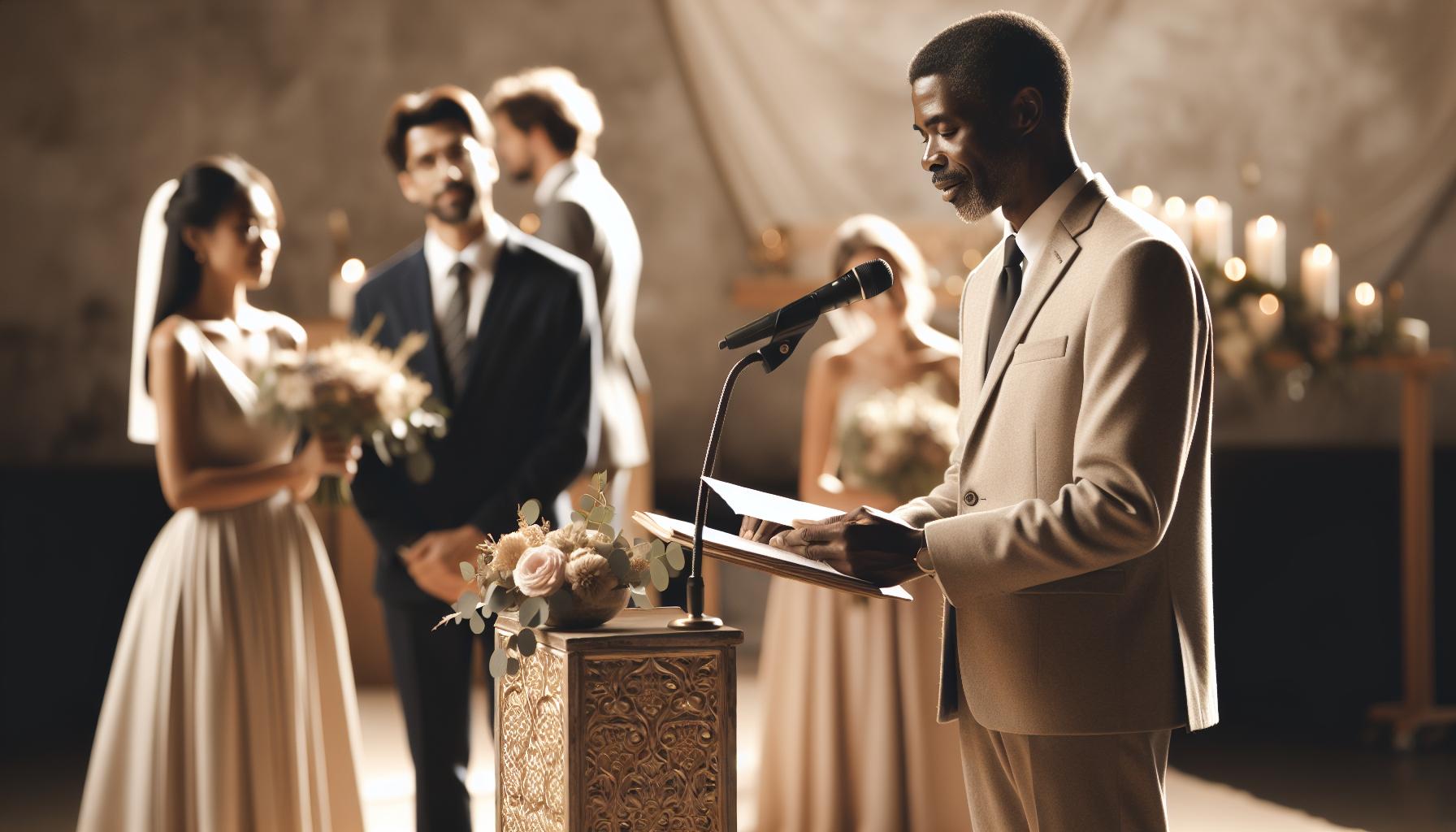
Heartfelt Opening Remarks: Setting the Right Tone
Every wedding begins with a moment steeped in emotion, where the officiant has the unique opportunity to set the tone for a joyful celebration. A skillful opening remark does more than welcome guests; it encapsulates the spirit of the occasion, igniting a sense of community and love. Consider starting with an engaging story or quote that resonates with the couple’s journey, as personal anecdotes can instantly create a more intimate atmosphere. For example, sharing a brief tale about how the couple met or their first adventure together encourages guests to feel connected not only to the couple but also to one another.
To ensure that your opening remarks resonate deeply, incorporate elements that celebrate love and relationships. This could range from a heartfelt reflection on the meaning of marriage-highlighting commitment, partnership, and the support that love provides-to a universally uplifting sentiment. Expressing how love nurtures and transforms individuals can remind everyone why they have gathered. A phrase like, “Today, we are here to witness a beautiful fusion of two hearts, each bringing their own story to this shared path,” sets a profound and respectful tone while encouraging everyone to reflect on their own journeys of love.
Additionally, don’t underestimate the power of inclusivity in your language. Whether the couple represents a blend of cultures or traditions, acknowledging these elements in your opening remarks helps everyone feel welcomed and valued. Including a nod to cultural backgrounds or specific traditions can enrich the ceremony and honor the diverse backgrounds of those in attendance.
Finally, remember that the pacing of your delivery is just as crucial as the words themselves. Speak with warmth and enthusiasm, allowing your genuine excitement to shine through. This spirited opening creates a sense of anticipation, energizing the guests as they prepare to witness the commitment that is about to unfold. By thoughtfully crafting this vital part of the ceremony, you help create a day that the couple-and everyone present-will cherish forever.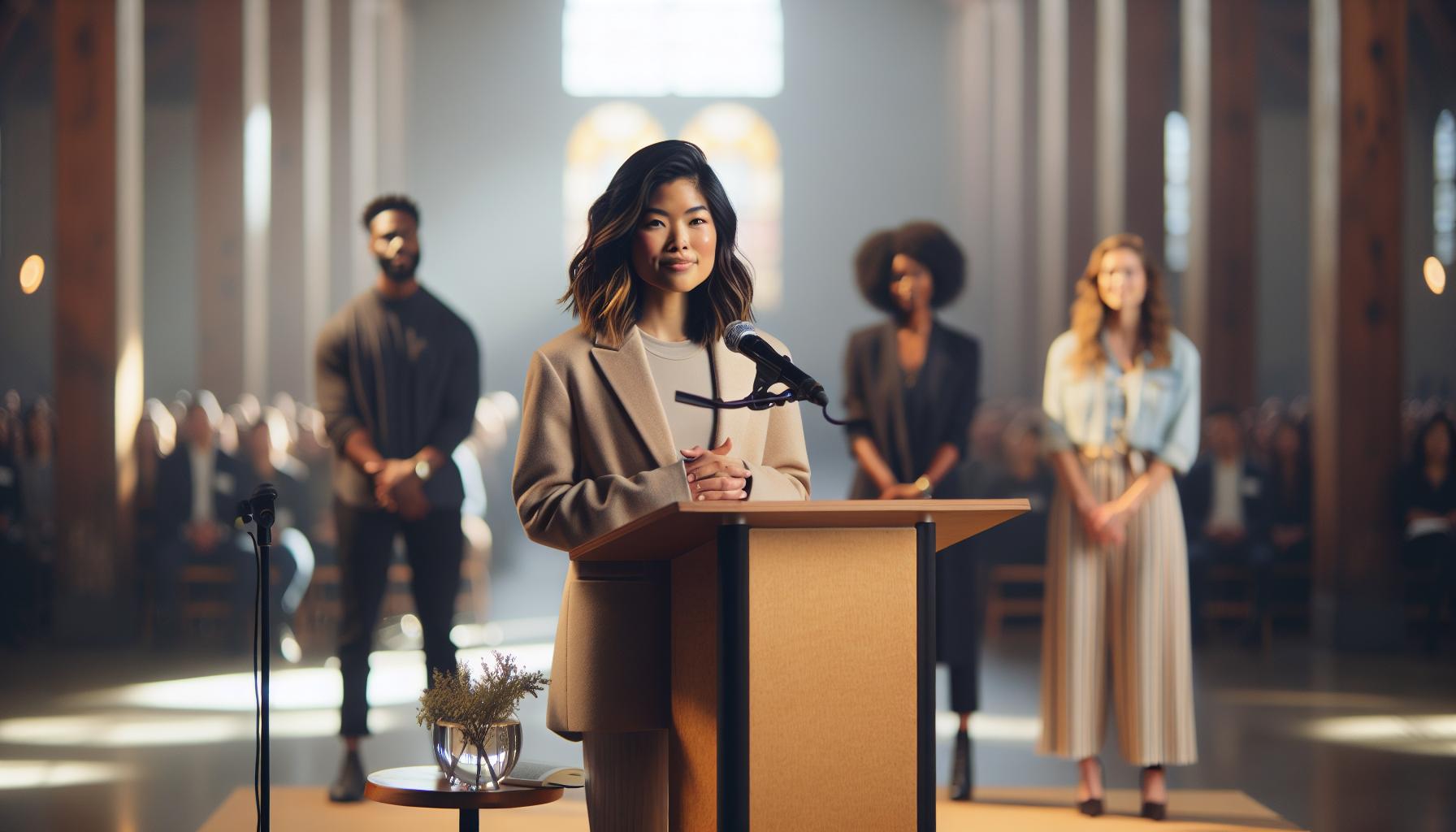
Crafting Personal Vows: Tips and Inspiration
Every couple approaches their wedding vows as a unique reflection of their love story, often leading to an emotional and memorable exchange that resonates deeply with the guests. Crafting personal vows might feel daunting, but it’s an incredible opportunity to express your feelings in a genuine and heartfelt way. Most importantly, remember that your vows don’t have to adhere to any strict rules; they should simply reflect your true emotions and commitment to one another.
To start creating your vows, consider the following tips and inspiration:
Identify Key Themes
Begin by reflecting on the main themes of your relationship. What brought you together? What qualities do you cherish most in your partner? Think about moments that defined your love, whether it’s the little things that make you smile or the big events that shaped your journey. This groundwork will help you articulate the core of your relationship.
Express Your Promises
Vows are promises made to each other, and it’s essential to articulate what you intend to uphold in your marriage. Here are some ideas to guide your promises:
- Commitment: “I promise to support you in all of your dreams and endeavors.”
- Partnership: “I will be your partner in all of life’s adventures, sharing the good times and helping to navigate the challenges.”
- Love: “I vow to always love you, as you are, and help you become the person you wish to be.”
Choosing words that resonate with your truth will not only deepen your vows but also create a palpable connection with your partner.
Incorporate Personal Touches
Add meaningful anecdotes or inside jokes to make your vows uniquely yours. For example, you might recount a silly moment or a challenge you overcame together, linking it to your commitment going forward. This personal touch not only keeps the vows light-hearted but also reinforces the bond you share.
Practice with Intention
Once you’ve written your vows, practice them aloud. This will help you gauge the flow of your words and make adjustments as needed. If you’re feeling nervous about speaking in front of guests, rehearsing in front of a mirror or with a trusted friend can boost your confidence. Remember, it’s not about delivering a perfect speech; it’s about speaking from the heart.
Ultimately, crafting your personal vows can be a rewarding aspect of your wedding ceremony that reflects your journey together. As you prepare, approach this task with love, creativity, and an openness to share your authentic selves. Your vows will not just be words spoken in the moment but cherished promises that will guide your relationship for years to come.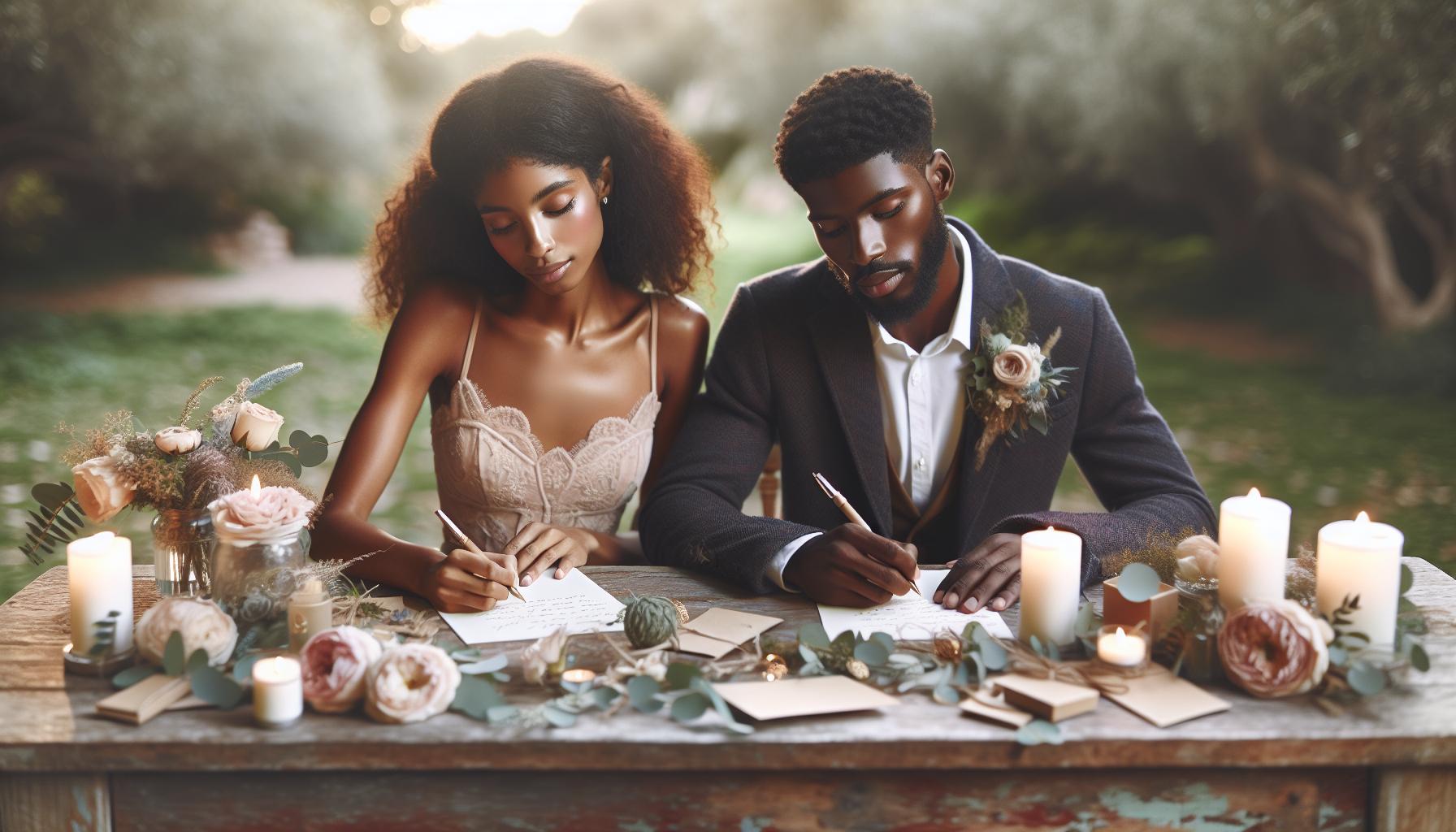
Readings and Rituals: Adding Meaningful Touches
Incorporating readings and rituals into your wedding ceremony can lend a deeply personal touch, transforming a standard exchange of vows into an unforgettable celebration of love. These elements serve not only as beautiful interludes but also as opportunities for reflection and connection among the couple and their guests. Whether you opt for poetry, prose, or a special family tradition, each reading or ritual can illuminate your love story and resonate with the hearts of everyone present.
Choosing Readings
When selecting readings, think about passages that speak to your relationship. Here are some wonderful options to consider:
- Poetry: Consider classic poets like Robert Frost or contemporary voices like Rumi, whose words resonate with themes of love and unity.
- Literature: Extracts from novels that have shaped your partnership can also be heartfelt choices. For instance, a quote from a favorite shared book can evoke memories and emotions.
- Religious Texts: If you have a spiritual foundation, writings from religious scriptures that emphasize love and commitment can beautifully underscore your vows.
- Custom Writings: Personal letters or notes exchanged between you can serve as tender reflections of your journey together.
Be sure to reflect on how each selection aligns with the tone you wish to set. Sharing these readings also allows family or friends to partake actively in your ceremony, creating an inclusive atmosphere.
Integrating Rituals
Rituals are a powerful way to symbolize your commitment and unite your families. Here are a few ideas:
- Candle Lighting Ceremony: Each partner can light a candle representing their individual lives, and then together light a central candle symbolizing their union.
- Sand Ceremony: Combining different colored sands into a single vessel can illustrate the blending of your lives.
- Unity Tree Planting: Planting a tree together during the ceremony signifies growth and the nurturing of your relationship.
- Handfasting: This ancient Celtic ritual involves tying your hands together to symbolize your bond, often accompanied by meaningful words and prayers.
These rituals can be customized based on your cultural backgrounds or personal preferences, lending authenticity and depth to your wedding.
Remember, whether you choose poignant readings or meaningful rituals, the most important element is that they reflect your personalities and love story. As you bring together the voices of your loved ones or the traditions of your families, you’ll create a ceremony that celebrates your unique connection-a moment that your guests will cherish just as much as you do.
Blending Traditions: Incorporating Cultural Elements
Integrating cultural elements into your wedding ceremony not only honors your heritage but also enriches the experience for both you and your guests. Many couples find that blending traditions creates a beautiful tapestry that reflects their unique love story and the diverse backgrounds they come from. Whether you are incorporating aspects from one culture or weaving together multiple traditions, the process can be both meaningful and celebratory.
To start, consider what customs resonate most with you and your partner. You might explore traditional dress, ceremonial rituals, or food that reflects your cultural heritage. For instance, if you’re embracing a Jewish tradition, incorporating the breaking of the glass can symbolize the fragility of relationships and the commitment to stand by one another through life’s challenges. Similarly, a traditional Indian wedding may feature a “saat phere” or seven circles around a sacred fire, each representing different vows.
When planning how to showcase these elements, consider the role of your officiant. They should be well-versed in the rituals and scripts relevant to the cultures being honored. Include a brief explanation of each tradition during your ceremony, helping guests understand the significance of each element. This not only educates your audience but also fosters a deeper connection among everyone present. You might even invite family members or friends to participate in readings or rituals, allowing them to share in the celebration while reinforcing the bonds of culture and community.
As you explore how to blend traditions, communicate openly with your partner about what aspects of each culture are most important to you both. This discussion can lead to creative compromises and personalized rituals that make your ceremony truly your own, such as crafting a unique unity ritual combining elements from both cultures. Ultimately, embracing your diverse backgrounds will not only enhance your wedding day but also lay a strong foundation for your future together-celebrating both where you came from and where you are headed.
Key Legal Responsibilities of the Officiant
The role of an officiant goes beyond just leading the ceremony; they are pivotal in ensuring the legal aspects of your marriage are properly handled. Understanding these responsibilities is crucial for ensuring that your wedding day goes off without a hitch and that your union is recognized by law. The officiant is tasked with several key legal responsibilities that safeguard the integrity of your marriage.
First and foremost, the officiant must be legally authorized to perform marriages in the location where the ceremony is taking place. This authority can vary by state or country, so it’s essential to verify their credentials and ensure they have the appropriate license or ordination. In some areas, even friends or family members can become officiants through a quick online application, while others require more formal processes.
Moreover, beyond their qualifications, the officiant has the important duty of ensuring that both parties meet the legal marriage requirements. This often includes confirming that the couple has obtained the necessary marriage license before the ceremony. The officiant should clearly explain any additional requirements to the couple, such as age restrictions or residency requirements, to avoid any surprises on the wedding day.
After the ceremony, the officiant must also file the marriage license with the appropriate governmental office. They typically handle the signing of this document, which includes signatures from the couple and witnesses. Failing to submit this paperwork in a timely manner can lead to significant legal complications for the newlyweds, including the potential invalidation of the marriage.
In addition to these core legal tasks, a skilled officiant will also weave together the ceremonial aspects with moments of joy and celebration, ensuring that the focus remains on the love shared between the couple. Their ability to blend these responsibilities while also providing a warm and engaging ceremony is what makes them a key player in your wedding. Always communicate openly with your officiant about these responsibilities to foster better partnership throughout your wedding planning journey.
Samples of Ceremony Structure: Inspiration for Your Script
Crafting a wedding ceremony script is an integral part of the wedding planning process and helps set the tone for the day. From heartfelt introductions to exchanging vows, every section of the ceremony can be infused with love and personal touches that reflect the couple’s journey together. Below is a suggested structure to inspire your ceremony script, along with key elements you might want to include.
Example Ceremony Structure
- Processional:
The ceremony typically begins with music as the bridal party walks down the aisle. This could include a special song that resonates with the couple. You might choose to have an introduction by the officiant to welcome everyone and set the atmosphere.
- Opening Remarks:
The officiant can start with a few warm words to greet the guests. This is an opportunity to express gratitude to family and friends for being part of the special day and to introduce the significance of the ceremony.
- Moment of Silence or Reflection (optional):
Depending on the couple’s preferences, a moment of silence can be a meaningful way to honor loved ones who are no longer present.
- Readings and Music:
Including a reading or a song can add depth to the ceremony. Select passages or poems that resonate with your love story or have special meaning to you both.
- Exchange of Vows:
One of the most intimate parts of the ceremony is when the couple exchanges vows. Personal vows allow each partner to express their love and commitment. Encourage couples to share anecdotes, promises for the future, or sentiments that reflect their unique relationship.
- Ring Exchange:
The officiant can explain the significance of wedding rings and lead the couple in exchanging rings, which serve as a symbol of their vows and love.
- Unity Ritual (optional):
This could be a sand ceremony, candle lighting, or another unique tradition that symbolizes the joining of two lives.
- Pronouncement of Marriage:
The officiant will announce the couple as married, marking a significant transition in the ceremony. This moment is often followed by a triumphant introduction, such as “You may now kiss!”
- Recessional:
The ceremony concludes with music as the couple walks back down the aisle together. This joyful moment signifies the beginning of their journey as a married couple.
- Post-Ceremony Details:
Following the ceremony, the officiant might include instructions for guests, such as directions to the reception or information about any activities planned.
Crafting your wedding ceremony script can seem daunting, but it allows you to shape a meaningful experience that reflects your individuality as a couple. Consider sharing with your officiant any personal stories, specific rituals, or cultural elements you wish to include. With these foundational elements, you can create a ceremony that resonates with the love and joy of your special day.
Expressing Gratitude: Closing Remarks to Guests
As the wedding ceremony draws to a close, this moment provides the officiant with a delightful opportunity to express heartfelt gratitude on behalf of the couple. Acknowledge the precious presence of each guest and emphasize the importance of their support and love, which has helped shape the couple’s journey. The closing remarks can serve as a bridge, connecting the solemnity of the ceremony with the joyous celebration that follows.
Begin by addressing the assembled friends and family with warmth and sincerity. A simple yet elegant phrase like, “Thank you all for joining us today to celebrate this beautiful union,” can set the right tone. Recognize that each individual contributes to the couple’s lives, saying something like, “Your love, guidance, and support mean the world to [Partner One] and [Partner Two], and they cherish each of you deeply.” This acknowledgment fosters a sense of togetherness and inclusion among the guests, reinforcing the communal aspect of the event.
Another key element is to encourage guests to carry the energy of the ceremony into the celebration. An uplifting statement such as, “Let’s continue this joyous occasion with laughter, love, and dancing!” can create excitement and elevate the collective mood as everyone transitions from a reflective ceremony to a celebratory reception. Additionally, reminding guests of the logistics, such as directions to the reception or following up with any specific plans, ensures that everyone feels welcomed and informed.
Incorporating a personal touch, perhaps sharing a meaningful quote or a cherished memory related to love and partnership, can enhance the emotional connection. A closing line that champions love, such as, “May the love you’ve witnessed here today inspire your own relationships,” leaves guests with an uplifting impression as they move forward to celebrate the newlyweds. This final note not only honors the couple’s commitment but also nurtures a spirit of love and camaraderie among all present.
Thinking Beyond the Norm: Creative Officiant Rituals
When it comes to wedding ceremonies, creativity can transform a traditional event into a uniquely personal celebration. Thinking beyond the standard structure, officiants have the opportunity to incorporate innovative rituals that capture the essence of the couple’s love and values. Rather than simply reading pre-written scripts, consider weaving in elements that resonate with the couple’s journey and their loved ones, making the ceremony an unforgettable experience.
One popular approach is to involve guests in a meaningful way. For example, a “wishing stone” ceremony allows guests to pass a smooth stone while offering well wishes or advice to the couple. As each guest shares their thoughts, the couple collects these stones in a special bowl to keep, serving as a tangible reminder of the support surrounding them. This adds a participatory element that brings everyone closer together, fostering a sense of community and love.
Another captivating ritual is the “unity ceremony,” which can go beyond the conventional candle lighting or sand pouring. Couples might consider more personalized rituals, such as planting a tree together to symbolize their growing bond or creating a piece of art that reflects their relationship. These acts of commitment allow couples to infuse their personalities into the ceremony and create lasting memories in a physical form.
Finally, storytelling can enhance the emotional depth of the ceremony. Officiants might share anecdotes about the couple’s journey leading up to the wedding, highlighting key moments or personal touches that define their relationship. Incorporating short, heartfelt stories not only engages the audience but also allows everyone to reflect on the love shared between the couple.
Embracing creativity opens the door to endless possibilities, encouraging couples and officiants alike to think outside the box. By infusing personal elements into the ceremony, the officiant helps craft a celebration that is both inspiring and deeply resonant, ensuring a memorable occasion that reflects the love story at its heart.
Frequently Asked Questions About Wedding Ceremonies
Many couples often find themselves wondering what exactly the officiant will say during their wedding ceremony. Understanding the various components not only alleviates anxiety but also allows couples to tailor their ceremony to reflect their unique love story. Officiants play a crucial role in setting the tone, guiding the couple through their vows, and incorporating meaningful elements that resonate with the couple and their guests.
One of the most important aspects of what the officiant says involves the opening remarks. This is typically where they welcome everyone and share sentiments about love and partnership. The officiant may draw upon personal anecdotes or inspirational quotes to connect with the audience and create an emotional backdrop for the ceremony. Following this, the officiant usually includes a section on the history of marriage or the significance of the day, which helps ground the ceremony in tradition while allowing for a personal touch.
Another key component is the vow exchange, where the officiant guides the couple through their promises to one another. This moment can be deeply personal, and couples are often encouraged to share custom vows that articulate their specific love and commitment. Officiants can support this by offering examples or prompts to help couples articulate their feelings, which often leads to one of the most memorable parts of the ceremony.
Including readings or rituals is also a common practice that officiants facilitate, enhancing the ceremony’s depth and meaning. These can include religious texts, poetry, or personal stories that resonate with the couple and reflect their values. Furthermore, rituals, such as a unity candle or sand ceremony, can serve as powerful symbols of the couple’s merging lives.
Finally, the officiant’s closing remarks serve as a joyful conclusion to the ceremony. Here, they typically express gratitude to the guests, offer well wishes to the couple, and introduce them as partners in marriage for the first time. This moment marks the extraordinary transition from individuals to a united couple and leaves a lasting impression on everyone present.
In essence, the officiant’s words set the stage for a celebration of love that is both personal and heartfelt. Planning each component of what the officiant will say can transform the ceremony into a true reflection of the couple’s journey and aspirations for the future.
FAQ
Q: What is the typical opening statement by the officiant during a wedding?
A: The typical opening statement by the officiant includes welcoming guests and setting the tone for the ceremony. For example, the officiant might say, “Welcome, family and friends. We are gathered here today to celebrate the love between [Name] and [Name] as they join together in marriage.”
Q: How can an officiant personalize the wedding ceremony script?
A: An officiant can personalize the wedding ceremony by incorporating anecdotes about the couple, discussing their journey together, or including quotes that resonate with their relationship. This makes the ceremony feel more meaningful and connected to the couple’s story.
Q: What traditional vows might an officiant suggest during the ceremony?
A: An officiant might suggest traditional vows such as, “I, [Name], take you, [Name], to be my wedded partner, to have and to hold, in sickness and in health, for richer or poorer, till death do us part.” This familiar language can create a sense of timelessness and sincerity.
Q: What are some essential elements the officiant must cover during the ceremony?
A: Essential elements the officiant must cover include the welcome address, the presentation of the couple, the exchange of vows, and the pronouncement of marriage. Each part ensures the ceremony flows smoothly and fulfills legal requirements.
Q: How can an officiant incorporate cultural traditions into the ceremony?
A: An officiant can incorporate cultural traditions by acknowledging them in the ceremony script and including rituals like candle lighting, sand ceremonies, or traditional readings. This respects the couple’s heritage and makes the ceremony more inclusive.
Q: What legal wording does an officiant need to include in the ceremony?
A: Legal wording an officiant may need to include includes the declaration of intent, such as, “Do you, [Name], take [Name] to be your wedded spouse?” This ensures the ceremony meets legal requirements for the marriage to be valid.
Q: How does an officiant express gratitude to the guests during the ceremony?
A: An officiant may express gratitude by saying, “Thank you all for being here today to celebrate this special occasion with [Name] and [Name]. Your presence means so much to them.” This acknowledgment fosters a sense of community and shared joy.
Q: What closing remarks do officiants typically make at a wedding?
A: Closing remarks often include a final blessing or good wishes for the couple, followed by the statement, “I now pronounce you married. You may kiss the bride/groom.” This signals the ceremony’s conclusion and invites celebration.
Final Thoughts
As you embark on this beautiful journey of love and commitment, remember that a well-crafted officiant script is key to setting the tone for your special day. Whether you’re looking for heartfelt vows or humorous readings, the right words can make your wedding ceremony truly memorable. Don’t leave your script to chance-explore personalized options that reflect your unique love story and connection.
To dive deeper into crafting the perfect ceremony, check out our guides on funny ceremony readings and cinematic wedding readings for inspiration that will delight your guests. If you have further questions or need assistance, our community is here to help. Sign up for our newsletter for the latest tips and resources. Your dream wedding is just around the corner-let’s make it unforgettable together!

